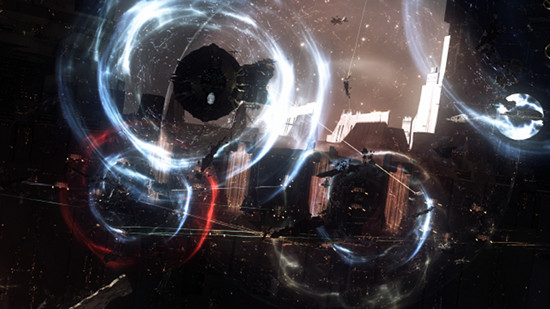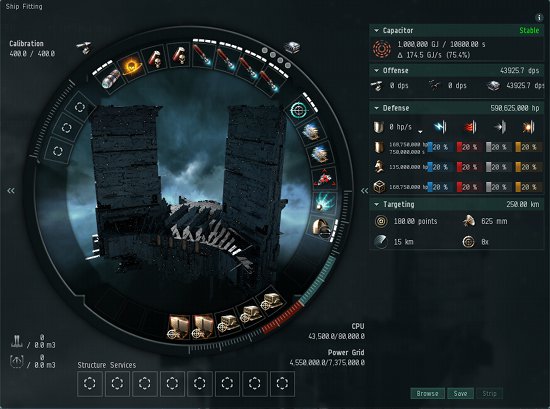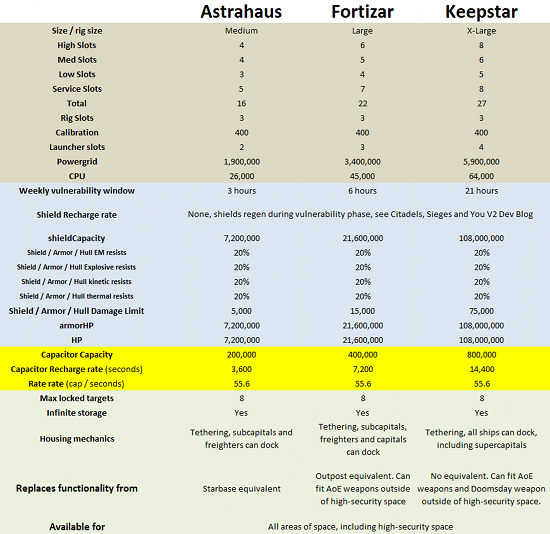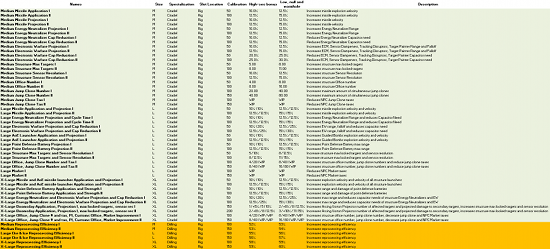Structure fitting in the EVE: Citadel expansion

Welcome to another blog on the upcoming Citadel expansion by Team Game of Drones. It’s been a while since we last discussed the Citadel feature and we felt some update was sorely needed. So come on in, make yourself comfortable and enjoy the show. Just stay clear of that mushroom-shaped house in the corner, that’s where CCP Guard lives.
The above picture shows our latest mass test involving a player fleet fight around the largest Citadel, the Keepstar. Model is work in progress. Picture courtesy from Lord_Maldoror.
Missed a structure blog? Have a look at the following:
- Back into the structure – introducing the structure changes coming to EVE Online and our long term plan
- Shake my Citadel – listing the first structure class to be worked on, as well as general mechanics
- Citadels, siege and you, v2 – capture and defense mechanics for EVE’s new structures
- I feel safe in citadel city – how assets are going to be saved and moved on structure destruction.
- Building your citadel, one block at a time – how Citadels are acquired and built
Fitting summary
Fitting of the Keepstar during one of our internal playtests.
Let’s recap what we have already talked about regarding fittings in case you haven’t followed progress closely since Fanfest 2015.
Unlike existing Starbases (also known as Player Owner Starbases or POSess), the new Citadels will not rely on deploying multiple structures to add more functionality to your little space castle. They will use a fitting system in a way almost identical to ships, with slots and modules to achieve customization gameplay.
These slots are sorted into different categories:
- High slots: dedicated to active modules--primarily weapons but also remote assistance modules--like our new structure missile launchers
- Mid slots: mainly aimed towards electronic warfare and electronic / remote assistance modules like ECM, Sensor Dampeners, or Target Painters
- Low slots: primarily used by engineering and passive modules, like weapon upgrades or reactor control modules
- Service modules: a new layer of modules designed to provide functionality currently offered by NPC stations or other in-game structures like Manufacturing, Research, Market, or even Cloning
- Rigs: provide further specialization into a specific structure role. For example, you fit a Market service module into a Citadel to get the basic activity, but the rig will be the item giving you bonuses like NPC tax reduction. Of course rigs are destroyed when removed, which makes them quite an investment
Structure bonuses and skills
In the same fashion that a Caldari Raven battleship doesn’t have the same role than a Scorpion, not all structures are going to be alike. Structures will focus on different themes, each having specific strengths and weaknesses. Citadels focus on defense, logistics, and office capabilities, which make them naturally good as staging points. Other structures we will introduce with time will tackle other fields like industry, resource harvesting, propaganda, intelligence or even long distance movement.
What that means in practice is that, while most of the various structure rigs and modules that are going to be available can be fitted into any type of hull, some will be better suited than others at a specific task. For instance, while a Fortizar (large Citadel) could be fitted with manufacturing service module and rigs, it will not offer as good Material Efficiency and Time Efficiency rates as a dedicated Assembly Array structure fitted on the same fashion.
This specialization will be achieved through the use of specific bonuses available on each of the new hulls.
For Citadels, these will be:
- 25% bonus to all Citadel rig strength
- 25% reduction to all Citadel service fuel costs
- 25% bonus to all Structure Missile Launcher damage
Unlike ships, these bonuses are fixed and not dependent on character skill level. In fact, no existing skill will affect any of the structure hulls, modules or rigs. That means Engineering will not increase powergrid on any of the new Citadels for instance, and that none of the missile support skills will function for the structure missile launchers.
This decision was made on purpose to:
- Prevent some poor soul from having to stay forever locked inside a Citadel to provide skill-level related bonuses
- Narrow the gap between new players and veterans in terms of skill proficiency when assuming direct control of the new structures. We want all players to be able to competitively participate, not require dedicated alternate accounts
We are still going to require a few skills to operate the structures and give few bonuses, but their effects will be limited for the reasons mentioned above.
- Structure Missile Systems: increases damage by 2% of all Structure Missile Launchers per level
- Structure Defensive Systems: reduces capacitor need of all structure defensive modules by 2% per level (not listing specific modules here since most of them won’t make it in the first Citadel release)
- Structure Electronic Systems: reduces capacitor need of Electronic Warfare, ship tractor beam, and bumping modules by 2% per level
- Structure Engineering Systems: reduces capacitor need of the Doomsday Device and Capacitor Warfare modules by 2% per level
All of these skills have rank 2, train with Charisma and Willpower, and have very low skill requirements.
Please note the Starbase Defense Management skill will stay untouched until we remove Starbases, at which point it will either be repurposed or reimbursed.
Fittings
Since the Citadels have slots, they rely on standard ship fittings like powergrid, CPU, or even calibration to install modules.
Details are listed below:
Some explanations:
- Service slots will use powergrid and CPU like regular modules.
- Existing ship modules cannot be fitted into the Citadels, and vice-versa.
- As mentioned on the “Citadels, Sieges and you v2” blog, the new structures automatically repair themselves during the repair state, as such there is no shield recharge rate on them.
- The damage mitigation is a hard limit on incoming damage the structure can take in a specific amount. More details on the blog linked just above.
- Citadels will be able to use fighter and fighter-bombers and their new mechanics tied to the capital ship overhaul also coming in the Citadel expansion.
- It is likely that Citadel slots and fittings will not be fully used during first release. This is intentional as we plan to add more modules as time passes.
- The new structures will be immune to most form of Electronic Warfare (EW) – specifically anything that can impede targeting, like ECM or Sensor Dampening.
Module and Rig List
We have listed most of the structure modules and rigs that will be shipped in the first release in the “Building your Citadel, one block at a time” blog. Now is the time to give you more details on what those modules actually do.
As usual, please note all names and numbers are subject to change based on time and playtests.
Service slots
- Market Hub: provides Market service to the structure. Cannot be fitted on Astrahus. Market orders are region wide, except in Wormhole space where they are system wide
- Cloning Center: provides medical and jump clone capabilities to the structure. Cloning Centers in Wormhole space structures will not allow players to jump clone back into the system, but can be used to swap clones around
- Reprocessing Plant: provides reprocessing capabilities to the structure
- Compression Plant: provides compression capabilities to the structure
High-slots
- Anti-capital Launcher: launcher fitted with missiles dedicated at taking capitals and supercapitals down. Their large explosion radius and poor explosion velocity are not suited for shooting subcapital ships.
- Anti-subcapital Launcher: launcher capable of using missiles made for shooting subcapital ships. Opposite of the Anti-capital Launcher listed above.
- Guided Bomb Launcher: uses guided bombs, which combine the tracking nature of missiles with the damaging area of effect of bombs. Has three ammunition types, one aimed at taking battleships down, another focused on killing frigates, and the last one having a capacitor draining effect
- Large / X-Large Energy Neutralizer: works exactly the same way than regular ship Energy Neutralizers. However, this specific module has a much larger amount of neutralized capacitor, capable of threatening capitals and crippling battleships
- Small / Medium Energy Neutralizers: same effect as above, but aimed against smaller ships.
- Point Defense Batteries: not to be confused with the flak missiles, this weapon generates AoE damage all around the structure, primarily to deal with enemy drones or frigates
- Ship Tractor Beam: a variation of the standard tractor beam. However it pulls ships instead of wrecks closer to the structure. The Ship Tractor Beam does not warp scramble its target however, which may cause it to align faster or slower depending on the angle on which it is pulled
- Arcing Vorton Projector: structure Doomsday module. Fires a beam of energy on the primary target, which then bounces on the five closest additional targets.
As a side-note, the various missiles shot from the structure launchers will either have high hitpoints or be invulnerable to attack to minimize firewall tactics. This will be decided during playtests. We are also going to increase all capital ship signature radius to at least 10km to account for the structure missiles listed above.
Med-slots
- Bumping module: causes all ships around the target to be bumped away at speeds based on their respective masses. Imagine being bumped by several raging Machariels and you will have a good idea on how this module operates
- Multi-spectrum ECM: equivalent to ship ECM in almost every way, except its racial strength can be changed through scripts
- Remote Sensor Dampener: works in the same fashion as its ship counterpart
- Stasis Webifier: works in the same fashion as its ship counterpart
- Tracking Disruptor: works in the same fashion as its ship counterpart
- Target Painter: works in the same fashion as its ship counterpart
- Warp Scrambler: works in the same fashion as its ship counterpart
Low-slots
- Ballistic Control System: increases Anti-capital, Anti-subcapital missiles and Guided Bombs damage and rate of fire
- Guidance Enhancer: improves explosion radius and velocity of Anti-capital missiles, anti-subcapital missiles and Guided Bombs
- Co-Processor: increases structure CPU at the expense of powergrid
- Signal Amplifier: increases structure maximum locked targets and scan resolution
- Reactor Control Unit: increases structure powergrid at the expense of CPU
Rigs:
Structure rigs will work a bit differently from ship rigs. While they require calibration and a matching structure hull size to be fitted, it will not be possible to fit more than one rig that affects the same attribute twice. For example, while you could fit the Medium Missile Application I and Medium Missile Projection I from the list below, it is not possible to fit both a Medium Missile Application I rig and the Medium Missile Application II rig on the Astrahus, or even two Medium Missile Application I rigs.
Another difference is that structure rig bonuses will vary based on the solar system security-status of the structure they’re in. As such, low-security, null-security and wormhole spaces will always receive better rig bonuses compared to high-security structures. This is made to preserve the various changes in gameplay in those different areas.
Finally, rigs of different sizes will offer the same bonuses, but will cover more or less attributes. For instance, while a Medium Missile Application I rig would offer 10% increase missile explosion velocity, the Large Missile Application and Projection I rig will still give a 10% increase to missile explosion velocity while also increasing missile velocity by 10% at the same time.
There may be exceptions to this – for instance the reprocessing rigs below do not follow this pattern as we want to preserve existing reprocessing differences between structure types.
Fuel Usage
Unlike existing Starbases, new structures will only require fuel when service modules are online.
The fuel cost is split up in two:
- One time cost for onlining, to discourage players from swapping service modules on and off to save fuel
- A recurring cost, charged at the beginning of each new hour, not 60 minutes after the module was activated. This is made to simplify fuel calculation costs for the user when faced with multiple modules
Since fuel costs are tied to individual service modules, it will be possible to consume more than existing Large Control Towers, or less than Small Control Towers depending on which activities are available. Below is a list of the four service modules we intend to ship with the Citadels and their associated fuel costs.
|
Service Module |
Onlining cost |
Recurring cost |
|
Market Hub |
2880 fuel blocks |
40 blocks / hour |
|
Cloning Center |
720 fuel blocks |
10 blocks / hour |
|
Reprocessing Plant |
360 fuel blocks |
5 blocks / hour |
|
Compression Plant |
360 fuel blocks |
5 blocks / hour |
We initially announced a new fuel block type that would be produced from all racial isotopes, but after much internal debate we’ve come up to the conclusion this creates a certain number of issues, one of which being too much hassle to import all the materials around.
As such we are going to allow the four existing fuel blocks to work with the Citadels for greater flexibility. Since Citadels don’t use Strontium Clathrates for their reinforcement mode, we will add this particular material into the composition of the four existing fuel blocks to maintain its demand. The current number we have in mind is 400 units of Strontium Clathrates for a batch of 40 fuel blocks.
As a side note, we are not going to require the use of the infamous Starbase Charters in high-security space as we feel it is an overkill requirement.
The End
As usual please remember all the above numbers are still works in progress! Expect changes in the future based on feedback and iteration. We are planning to release the new structure skills and change the existing structure components as mentioned in the last Blog in March to give you guys some time to adjust before we release Citadels. We are also planning external playtests on our test servers, so keep your eyes peeled for updates.






